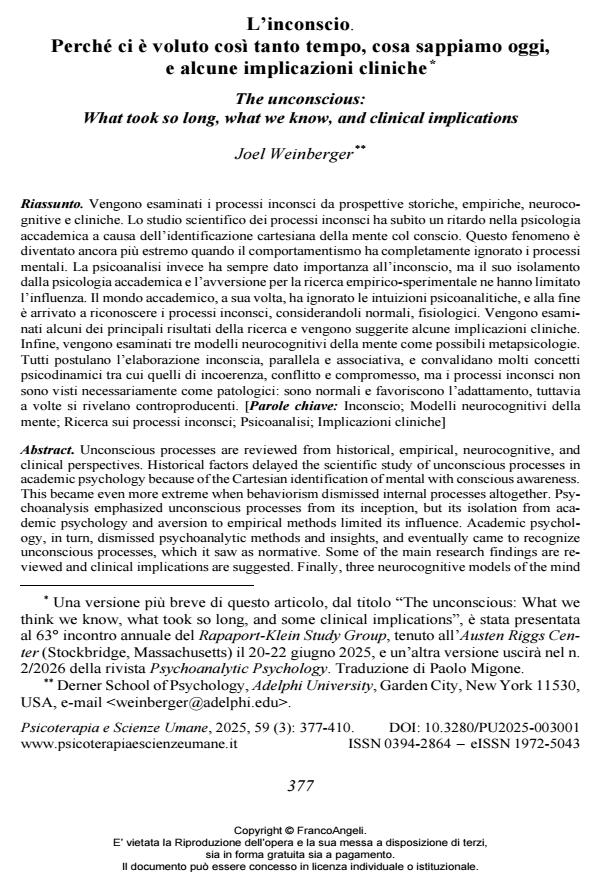L’inconscio. Perché ci è voluto così tanto tempo, cosa sappiamo oggi, e alcune implicazioni cliniche
Titolo Rivista PSICOTERAPIA E SCIENZE UMANE
Autori/Curatori Joel Weinberger
Anno di pubblicazione 2025 Fascicolo 2025/3
Lingua Italiano Numero pagine 34 P. 377-410 Dimensione file 347 KB
DOI 10.3280/PU2025-003001
Il DOI è il codice a barre della proprietà intellettuale: per saperne di più
clicca qui
Qui sotto puoi vedere in anteprima la prima pagina di questo articolo.
Se questo articolo ti interessa, lo puoi acquistare (e scaricare in formato pdf) seguendo le facili indicazioni per acquistare il download credit. Acquista Download Credits per scaricare questo Articolo in formato PDF

FrancoAngeli è membro della Publishers International Linking Association, Inc (PILA)associazione indipendente e non profit per facilitare (attraverso i servizi tecnologici implementati da CrossRef.org) l’accesso degli studiosi ai contenuti digitali nelle pubblicazioni professionali e scientifiche
Vengono esaminati i processi inconsci da prospettive storiche, empiriche, neurocognitive e cliniche. Lo studio scientifico dei processi inconsci ha subìto un ritardo nella psicologia accademica a causa dell’identificazione cartesiana della mente col conscio. Questo fenomeno è diventato ancora più estremo quando il comportamentismo ha completamente ignorato i processi mentali. La psicoanalisi invece ha sempre dato importanza all’inconscio, ma il suo isolamento dalla psicologia accademica e l’avversione per la ricerca empirico-sperimentale ne hanno limitato l’influenza. Il mondo accademico, a sua volta, ha ignorato le intuizioni psicoanalitiche, e alla fine è arrivato a riconoscere i processi inconsci, considerandoli normali, fisiologici. Vengono esaminati alcuni dei principali risultati della ricerca e vengono suggerite alcune implicazioni cliniche. Infine, vengono esaminati tre modelli neurocognitivi della mente come possibili metapsicologie. Tutti postulano l’elaborazione inconscia, parallela e associativa, e convalidano molti concetti psicodinamici tra cui quelli di incoerenza, conflitto e compromesso, ma i processi inconsci non sono visti necessariamente come patologici: sono normali e favoriscono l’adattamento, tuttavia a volte si rivelano controproducenti.
Parole chiave:Inconscio; Modelli neurocognitivi della mente; Ricerca sui processi inconsci; Psicoanalisi; Implicazioni cliniche
Joel Weinberger, L’inconscio. Perché ci è voluto così tanto tempo, cosa sappiamo oggi, e alcune implicazioni cliniche in "PSICOTERAPIA E SCIENZE UMANE" 3/2025, pp 377-410, DOI: 10.3280/PU2025-003001